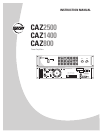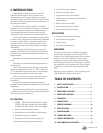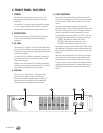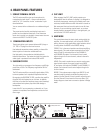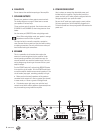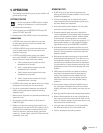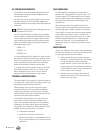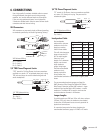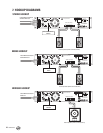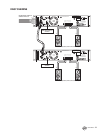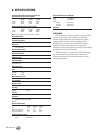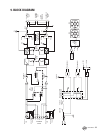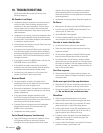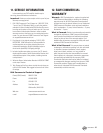
14 – CAZ Series
10. TROUBLESHOOTING
Sound system diffi culties usually fall into one of the
following categories.
No Sound or Low Output
• Loudspeaker cables or connectors are not wired correctly
or they are faulty. Check all cabling, referring to these
instructions for the correct connections. The best way to
check a suspect cable is to swap it with a known good
cable. Read the loudspeaker’s input panel to verify correct
cable connections.
• Loudspeaker is not working. Connect the loudspeaker cable
to a known good loudspeaker leaving all equipment set to
the same levels. If the problem disappears, the loudspeaker
is probably not working correctly.
• Are the channel Level controls turned up? Slowly turn them
up and see if you hear anything.
• Is the signal source turned up? Make sure the signal level
from the mixing console (or whatever device immediately
precedes the amplifi er) is high enough to produce sound in
the amplifi er. The SIG LEDs should be blinking to indicate
that signal is present.
• If the speakers are wired for BRIDGE mode, make sure the
AMP MODE switch is set to BRIDGE.
• If the amplifi er has gotten extremely hot, the thermal
protection circuit may have activated. Allow the amplifi er
to cool down and normal operation should resume.
• Are there fuses in the speakers, or in-line fuses in the
speaker wire? Check to see if they’re blown.
Distorted Sound
• The power amplifi er is clipping. The signal level is
exceeding the limits of your system and you must reduce
the level from your mixer or signal source.
• Ensure that no equipment in the signal chain is being over
driven. For example: input(s) or summing bus in the mixing
console, equalizers etc.
• Is the input connector plugged completely into the
jack? Check the speaker connections and verify that all
connections are tight and that there are no stray strands of
wire shorting across the speaker terminals.
• If possible, listen to the signal source with headphones
plugged into the console. If it sounds bad there, the
problem is not in the amplifi er.
• Loudspeakers not working properly.
Partial Sound (frequency band missing)
• Incorrect EQ settings in the electronic equipment. Ensure
all EQ settings and fi lters on the mixing console or
preamplifi er and on other equipment are set for normal
operation. Ensure level controls on electronic crossovers
and associated amplifi ers are correctly set and that all
cables and connections for such equipment are connected
and working properly.
• Loudspeaker not working properly. Swap with a good one.
No Power
• Make sure the AC outlet is live and the POWER switch on.
• Is the LED next to the POWER switch illuminated? If not,
make sure the AC outlet is live.
• Has the BREAKER switch popped?
• The fuses inside the amplifi er have blown. These are not a
user-serviceable. See next page about service.
One side is louder than the other
• Are both Level controls set to the same position?
• Check your source signal to make sure the left and right
signals are balanced.
• Are the speaker impedances matched? Different speaker
loads can cause different volume levels on each side.
• Try switching sides: Turn off the amp, swap the speaker
cables at the amp, turn the amp back on. If the same side is
still louder, the problem is with your speaker cabling. If the
other side is louder now, the problem is with the mixer, the
amp, or the line-level cabling.
Poor Bass response
• Check the polarity of the speaker cable connections. You
may have your positive and negative reversed at one end of
one speaker cable.
As the music gets loud, the amp shuts down
• Make sure the OL LEDs are not lighting continuously. If so,
turn down the signal source or the amp Level controls.
• Can the amp breathe? It needs plenty of fresh air to stay
cool. Do not block the ventilation holes.
Noise/Hum
• Check the signal cable between the mixer and the
amplifi er. Make sure all connections are good and sound.
• Make sure the signal cable is not routed near AC cables,
power transformers, or other EMI-inducing devices.
• Is there a light dimmer or other SCR-based device
on the
same AC circuit as the amplifi er? Use an AC
line fi lter, or
plug the amplifi er into a different AC circuit.
• If possible, listen to the signal source with headphones
plugged into the console. If it sounds noisy there, the
problem is not in the amplifi er.
• Is there a cable-TV audio feed in your system? An incorrect
ground may causes a "ground loop" hum.



